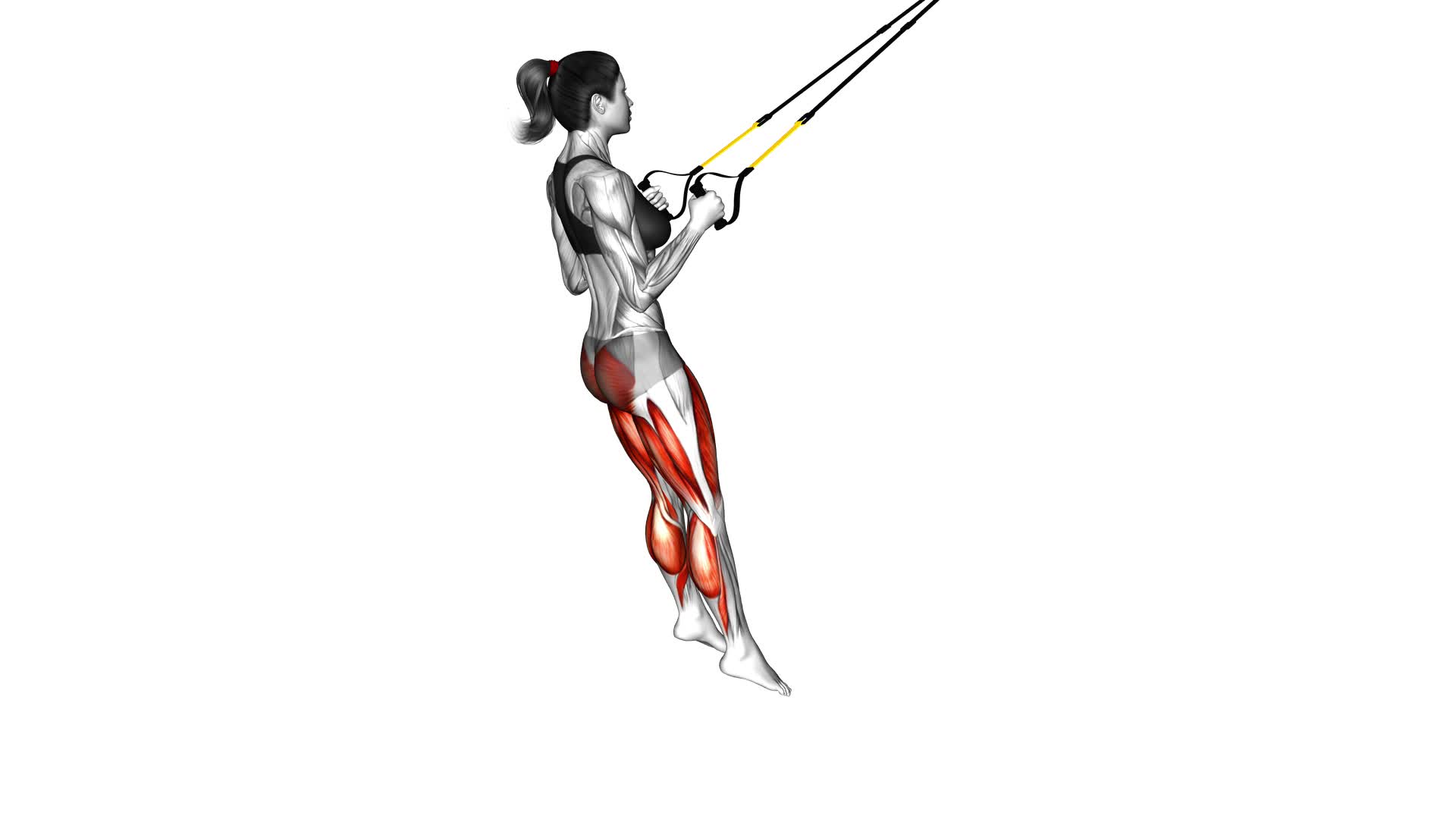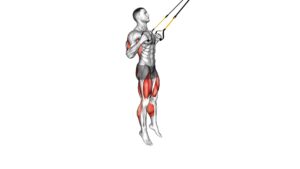Suspender Jump Squat (female) – Video Exercise Guide & Tips

Are you looking for a challenging and effective lower body exercise? Look no further than the suspender jump squat! This exercise targets your glutes, quads, and hamstrings, helping you build strength and power.
Watch This Exercise Video
In this video exercise guide, we'll show you the proper form and technique to maximize your results. Whether you're a beginner or advanced, we'll also provide modifications to suit your fitness level.
Get ready to take your squat game to the next level with the suspender jump squat.
Key Takeaways
- The Suspender Jump Squat targets multiple lower body muscles and improves strength, endurance, and explosive power.
- Proper form and technique are important, including maintaining a stable stance, engaging the core, and driving through the heels during the explosive phase.
- Common mistakes to avoid include using improper form, not landing softly, neglecting warm-up, and overdoing it. Rest and recovery time are crucial.
- Modifications can be made for different fitness levels, such as using resistance bands or weighted suspenders, adjusting the height of the jump, and gradually increasing difficulty.
Benefits of the Suspender Jump Squat
You will experience numerous benefits from incorporating the Suspender Jump Squat into your exercise routine. This exercise is a form of plyometric training, which involves explosive movements to build power and increase muscular endurance. The Suspender Jump Squat specifically targets your lower body muscles, including your quadriceps, hamstrings, glutes, and calves. By performing this exercise regularly, you can expect to see improvements in your overall lower body strength and endurance.
Muscular endurance is the ability of your muscles to work continuously over an extended period of time. By incorporating the Suspender Jump Squat into your routine, you'll be challenging your muscles to repeatedly contract and extend, helping to improve their endurance. This can be especially beneficial for athletes who participate in activities that require repetitive jumping or explosive movements.
Additionally, plyometric training, like the Suspender Jump Squat, can help improve your athletic performance. By increasing your power and explosive strength, you may find that you can jump higher, run faster, and perform better in sports or activities that require quick, explosive movements.
Incorporating the Suspender Jump Squat into your exercise routine can be an effective way to build lower body strength, increase muscular endurance, and improve your athletic performance.
Proper Form and Technique
To ensure proper execution of the Suspender Jump Squat, focus on maintaining a stable and balanced stance throughout the exercise. This is crucial for improving balance and increasing power. Start by standing with your feet shoulder-width apart and your toes pointing slightly outward. Keep your core engaged and your chest lifted throughout the exercise.
Begin the movement by bending your knees and lowering your hips down into a squat position. Make sure to keep your knees in line with your toes, and avoid letting your knees collapse inward. Your weight should be distributed evenly between both feet.
From the squat position, explode upwards by pushing through your heels and driving your hips forward. As you jump, extend your legs fully and lift your arms up in front of you for balance. Land softly with a slight bend in your knees to absorb the impact.
To maintain proper form, avoid rounding your back or leaning forward excessively during the exercise. Keep your gaze forward and maintain a neutral spine throughout. It may be helpful to practice the movement without the suspension straps first to ensure you have the proper form and technique down.
Common Mistakes to Avoid
Avoiding common mistakes is key to performing the Suspender Jump Squat correctly. To ensure that you avoid injuries and maximize your results, here are four common mistakes to avoid:
- Using improper form: It's important to maintain proper form throughout the exercise. Avoid rounding your back or letting your knees collapse inward. Keep your chest up, engage your core, and push through your heels to maintain stability and prevent injury.
- Not landing softly: When performing the jump squat, make sure to land softly to reduce the impact on your joints. Avoid landing with your knees locked or landing heavily, as this can lead to knee and ankle injuries. Instead, focus on landing softly and quietly, bending your knees to absorb the impact.
- Neglecting to warm up: Skipping a proper warm-up can increase your risk of injury. Before starting the Suspender Jump Squat, warm up your muscles with dynamic stretches or light cardiovascular exercises. This will help increase blood flow, improve flexibility, and prepare your body for the intense workout.
- Overdoing it: While it's important to challenge yourself, overdoing the Suspender Jump Squat can lead to overuse injuries or muscle imbalances. Gradually increase the intensity and volume of your workouts to avoid pushing your body too hard. Listen to your body and give yourself adequate rest and recovery time.
Modifications for Different Fitness Levels
To accommodate different fitness levels, what modifications can be made to the Suspender Jump Squat exercise? There are several progression options and equipment variations that can be used to modify the exercise based on individual fitness levels.
For beginners or those with lower fitness levels, it's advisable to start with a modified version of the Suspender Jump Squat. Instead of using actual suspenders, you can use resistance bands or a stability ball to provide support and assistance during the exercise. This will help reduce the impact on your joints and make it easier to perform the movement.
As you progress and become more comfortable with the exercise, you can gradually increase the difficulty by using actual suspenders or weighted suspenders. This will add resistance and challenge your muscles even more, helping to build strength and power.
Additionally, you can modify the exercise by adjusting the height of the jump. For beginners, it may be more appropriate to start with a smaller jump and gradually increase the height as you become stronger and more confident.
Tips for a More Effective Workout
For a more effective workout, focus on proper form and engage your core throughout the Suspender Jump Squat exercise. To maximize your results and increase the intensity of this exercise, follow these tips:
- Keep your feet shoulder-width apart and your knees slightly bent. This will help you maintain stability and prevent unnecessary strain on your joints.
- As you squat down, make sure to keep your chest up and your back straight. This will engage your glutes and quadriceps more effectively.
- When you jump, explode upwards with power and land softly on the balls of your feet. This will help you build explosive strength and minimize the impact on your joints.
- To increase the intensity, you can add a dumbbell or kettlebell to the exercise. Hold it close to your chest while performing the jump squat, which will challenge your muscles even more.
By following these tips, you can ensure that you're getting the most out of your Suspender Jump Squat workout.
Now, let's move on to the next section and discuss the safety precautions to consider.
Safety Precautions to Consider
Now let's focus on ensuring your safety during the Suspender Jump Squat exercise by considering important precautions. Safety should always be a top priority when engaging in any physical activity.
To minimize the risk of injury, it's essential to use the appropriate safety equipment and warm up properly before starting the exercise.
Firstly, it's recommended to wear proper safety equipment such as supportive athletic shoes that provide stability and cushioning. This will help protect your feet and ankles from any potential impact or strain during the exercise. Additionally, it's advisable to wear comfortable and breathable clothing that allows for ease of movement.
Before attempting the Suspender Jump Squat, it's crucial to warm up your body. Perform dynamic stretches to loosen up your muscles and increase blood flow to the working areas. This can include exercises like leg swings, arm circles, and high knees. Warming up prepares your body for the intensity of the exercise and reduces the risk of muscle strains or sprains.
Remember to start with a lower intensity and gradually increase as you become more comfortable and confident with the exercise. Listen to your body and if you feel any pain or discomfort, stop immediately to prevent injury.
Always consult with a healthcare professional before starting any new exercise routine, especially if you have any pre-existing medical conditions.
Frequently Asked Questions
How Many Calories Does the Suspender Jump Squat Burn?
Including the suspender jump squat in your workout routine has numerous benefits.
Not only does it help to burn calories, but it also strengthens your lower body muscles, including your glutes, quads, and hamstrings.
This exercise can also improve your explosive power and agility.
To perform the suspender jump squat for maximum results, start by placing your feet shoulder-width apart, then lower into a squat position.
Explosively jump up, extending your hips and knees, and land softly back into the squat position.
Can the Suspender Jump Squat Help Improve Vertical Jump Height?
The Suspender Jump Squat is a plyometric exercise that can help improve your vertical jump height. By incorporating explosive power movements into your workout routine, you can enhance your overall athletic performance.
Plyometric exercises like the Suspender Jump Squat focus on developing fast-twitch muscle fibers, which are essential for generating power and explosiveness. Adding this exercise to your training regimen can provide numerous benefits, such as increased leg strength and improved jumping ability.
How Often Should I Include the Suspender Jump Squat in My Workout Routine?
To optimize your workout routine, it's important to consider how often you include the suspender jump squat.
Resting between sets is crucial for recovery and muscle growth, so aim for 1-2 minutes of rest.
Additionally, be mindful of common mistakes when performing the exercise. Ensure proper form by keeping your back straight, knees aligned with your toes, and landing softly.
Are There Any Alternative Exercises That Target Similar Muscle Groups as the Suspender Jump Squat?
If you're looking for alternative exercises that target similar muscle groups as the Suspender Jump Squat, there are a few options you can try.
One option is the regular Jump Squat, which focuses on your lower body and helps improve explosive power.
Another option is the Bulgarian Split Squat, which targets your quads, glutes, and hamstrings.
Lastly, the Box Jump is a great exercise for working your lower body and increasing your vertical jump.
Can the Suspender Jump Squat Help Improve Agility and Quickness?
The suspender jump squat is a great exercise for improving agility and quickness. By incorporating explosive jumps and squats, it targets your leg muscles and helps to increase power and speed.
Additionally, this exercise also improves overall fitness by engaging your core and promoting cardiovascular endurance.
To perform it effectively, start with your feet shoulder-width apart, jump explosively into the air while squatting down, and land softly with bent knees.
Repeat for maximum benefits.
Conclusion
In conclusion, the suspender jump squat is a highly effective exercise that targets multiple muscle groups in the body. By following the proper form and technique, individuals can maximize the benefits of this exercise and avoid common mistakes.
Modifications can be made to accommodate different fitness levels, and incorporating these tips will lead to a more effective workout. However, it's important to prioritize safety and consider any necessary precautions before attempting this exercise.

Author
Years ago, the spark of my life’s passion ignited in my mind the moment I stepped into the local gym for the first time. The inaugural bead of perspiration, the initial endeavor, the very first surge of endorphins, and a sense of pride that washed over me post-workout marked the beginning of my deep-seated interest in strength sports, fitness, and sports nutrition. This very curiosity blossomed rapidly into a profound fascination, propelling me to earn a Master’s degree in Physical Education from the Academy of Physical Education in Krakow, followed by a Sports Manager diploma from the Jagiellonian University. My journey of growth led me to gain more specialized qualifications, such as being a certified personal trainer with a focus on sports dietetics, a lifeguard, and an instructor for wellness and corrective gymnastics. Theoretical knowledge paired seamlessly with practical experience, reinforcing my belief that the transformation of individuals under my guidance was also a reflection of my personal growth. This belief holds true even today. Each day, I strive to push the boundaries and explore new realms. These realms gently elevate me to greater heights. The unique combination of passion for my field and the continuous quest for growth fuels my drive to break new ground.



